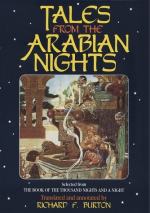[FN#344] Gen. “Baysar” or “Faysar,” = beans cooked in honey and milk. See retro, Night ccclxxxviii., for its laxative properties.
[FN#345] [In the Ms. “barbastu,” with the dental instead of the palatal sibilant (Sin instead of Sad). Spelled in the former way the verb “barbasa” means, he sought, looked for, and is therefore out of place here. Spelled in the second manner, it signifies literally, he watered the ground abundantly. Presently we shall find the passive participle “mubarbasah” in the feminine, because referring to the noun “Tiz” = anus, which, like its synonym, “1st,” professes the female gender. —St.]
[FN#346] [In Ar. “Mubarbasah,” for which see the preceding note.—St.]
[FN#347] The Moslem’s tomb is an arched vault of plastered brick, large enough for a man to sit up at ease and answer the Questioning Angels; and the earth must not touch the corpse as it is supposed to cause torture. In the graves of the poorer classes a niche (lahad) offsets from the fosse and is rudely roofed with palm-fronds and thatch. The trick played in the text is therefore easy; see Lane’s illustration M.E. chapt. xviii. The reader will not forget that all Moslems make water squatting upon their hunkers ina position hardly possible to an untrained European: see vol. i. 259.
[FN#348] The bull being used in the East to turn the mill and the water-wheel; vol. i. 16.
[FN#349] In text “Ratl.” See vol. iv. 124.
[FN#350] About 1s. 2d.
[FN#351] The man was therefore in hiding for some crime. [The Ms. has “la tafzah-ni” = Do not rend my reputation, etc. I would, therefore, translate “Sahib-ha” by “her lover,” and suggest that the crime in question is simply what the French call “conversation criminelle.”—St.]
[FN#352] The “’Isha"-prayer (called in Egypt “’Eshe”) consists of ten “Ruka’at” = bows or inclinations of the body (not “of the head” as Lane has it, M.E. chapt. iii.): of these four are “Sunnah” = traditional or customary (of the Prophet), four are Farz (divinely appointed i.e. by the Koran) and two again Sunnah. The hour is nightfall when the evening has closed in with some minor distinctions, e.g. the Hanafi waits till the whiteness and the red gleam in the west ("Al-Shafak al-ahmar”) have wholly disappeared, and the other three orthodox only till the ruddy light has waned. The object of avoiding sundowntide (and sunrise equally) was to distinguish these hours of orisons from those of the Guebres and other faiths which venerate, or are supposed to venerate, the sun.
[FN#353] Scott. “History of the Sultan of Hind,” vol. vi. 194-209.
[FN#354] Red robes being a sign of displeasure: see vol. iv. 72; Scott (p. 294) wrongly makes them “robes of mourning.”
[FN#355] A Moslem negroid from Central and Western North Africa. See vol. ii. 15. They share in popular opinion the reputation of the Maghrabi or Maroccan for magical powers.




